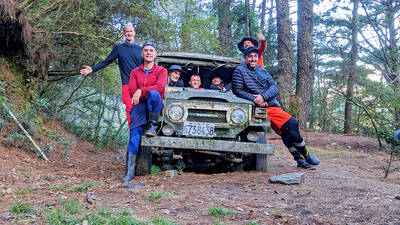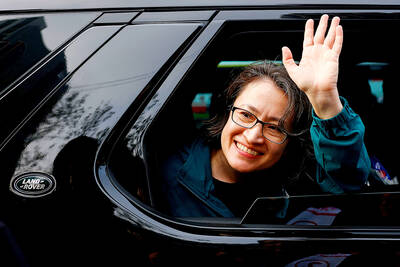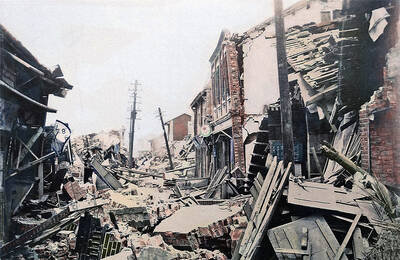In high schools across the world, students regularly gather at specific times round Stevenson screens, white louvre boxes filled with scientific instruments, to make measurements and observations. The students are part of a study being conducted by the National Aeronautics and Space Administration (NASA).
While studying at Taipei First Girls' High School (TFG,
Every break time when the satellites Terra and Aqua passed over Taiwan, she and her classmates in the Earth Science Club would congregate round the Stevenson screen. Together they filled in sheets downloaded from NASA's Web site with information on the temperature, humidity, and types of clouds in the sky. Sometimes, Lin would take pictures of the clouds. Her shots won three consecutive cloud photo contests held by NASA, beginning in 2003.

PHOTO: GINGER YANG, TAIPEI TIMES
Now, Lin is a history major in National Taiwan Normal University (
The project, Students' Cloud Observations On-Line (S'COOL), involves over 1,700 schools across the US and in 60 other countries, according to the S'COOL's Web site. Eight schools in Taiwan participated in the project last year. All participants document surface-based observations and post the results on the Web site.
The rational for S'COOL is vali-dation. Clouds are powerful agents of global climate change as they affect overall temperature and the energy balance of the Earth, thereby playing an important role in controlling the planet's long-term climate.

PHOTO: GINGER YANG, TAIPEI TIMES
To understand the impact of clouds over time, satellites take measurements. The data from NASA's ERBE and CERES satellite instruments, for example, have made and continue to make significant contributions to the understanding of clouds.
The satellite information must be validated by measurements from aircraft and ground stations. This is where S'COOL comes in.
"Because NASA needs data from so many locations, it is a really brilliant idea to use school kids from all around the world to collect data," said Wu Yu-ya (吳育雅), an earth science teacher at TFG. "This project encourages students to turn their eyes from textbooks to nature; to see the sky and the clouds."

PHOTOS COURTESY OF SANDY LIN
Lin recalls throwing herself into the S'COOL project with great ardour. She never missed a single observation, even though other students sometimes found this routine boring. She enjoyed the whole process. "I still miss the Stevenson screen," said Lin.
"NASA was a remote, impossible dream, but this project makes each of us become a `member' of NASA. I realized that I can contribute to NASA," Lin said.
Lu Chao-ying (盧超英), a TFG geography teacher, believes this sense of involvement and participation is important for students: "Our students have the potential to achieve something big, to be part of an international project," she said.

A new generation of students at TFG and Wu's withdrawal from the project has seen the initiative pass to other schools, including Zhongshan Girls' Senior High School (
This March and April, Zhongshan school moved up to 10th place, an indication of the high quality and consis-tency of its observations.
"I am happy to hear the news. Paying attention to the earth is as important as getting good grades," said Ting Ya-wen (丁亞雯), the principal at Zhongshan school. The school has the second largest climate observation facility in Taiwan.

Huang Kai-fu (黃凱夫), an earth science teacher at the Zhongshan Girls' Senior High School, said that students need to take real pleasure in their work if they are to be effective in making observations. "Identifying the different kinds of clouds is no simple matter. Formations change so quickly that it is hard to determine (what kind they are). Unless you like it, you will find the work frustrating."
According to Kirsten Liu (
Another TFG participant, Liu Lu-hang (劉綠杭), summed up the project as a mixture of science and the appreciation of nature. In the Chinese version of the S'COOL Web site, she writes "Every time when I look up to the sky, various questions would come in to my mind: How can cirrus be shaped like hair? Why do (Cirrocumulus) clouds sometimes
arrange themselves in such an orderly way? Why does the color of the sky at dusk or night differ everyday?"
Perhaps through a project like S'COOL, she will be inspired to find out.
More information about the S'COOL project can be found at asd-www.larc.nasa.gov/SCOOL/.

The year was 1991. A Toyota Land Cruiser set out on a 67km journey up the Junda Forest Road (郡大林道) toward an old loggers’ camp, at which point the hikers inside would get out and begin their ascent of Jade Mountain (玉山). Little did they know, they would be the last group of hikers to ever enjoy this shortcut into the mountains. An approaching typhoon soon wiped out the road behind them, trapping the vehicle on the mountain and forever changing the approach to Jade Mountain. THE CONTEMPORARY ROUTE Nowadays, the approach to Jade Mountain from the north side takes an

Last week Joseph Nye, the well-known China scholar, wrote on the Australian Strategic Policy Institute’s website about how war over Taiwan might be averted. He noted that years ago he was on a team that met with then-president Chen Shui-bian (陳水扁), “whose previous ‘unofficial’ visit to the US had caused a crisis in which China fired missiles into the sea and the US deployed carriers off the coast of Taiwan.” Yes, that’s right, mighty Chen caused that crisis all by himself. Neither the US nor the People’s Republic of China (PRC) exercised any agency. Nye then nostalgically invoked the comical specter

Relations between Taiwan and the Czech Republic have flourished in recent years. However, not everyone is pleased about the growing friendship between the two countries. Last month, an incident involving a Chinese diplomat tailing the car of vice president-elect Hsiao Bi-khim (蕭美琴) in Prague, drew public attention to the People’s Republic of China’s (PRC) operations to undermine Taiwan overseas. The trip was not Hsiao’s first visit to the Central European country. It was meant to be low-key, a chance to meet with local academics and politicians, until her police escort noticed a car was tailing her through the Czech capital. The

April 15 to April 21 Yang Kui (楊逵) was horrified as he drove past trucks, oxcarts and trolleys loaded with coffins on his way to Tuntzechiao (屯子腳), which he heard had been completely destroyed. The friend he came to check on was safe, but most residents were suffering in the town hit the hardest by the 7.1-magnitude Hsinchu-Taichung Earthquake on April 21, 1935. It remains the deadliest in Taiwan’s recorded history, claiming around 3,300 lives and injuring nearly 12,000. The disaster completely flattened roughly 18,000 houses and damaged countless more. The social activist and